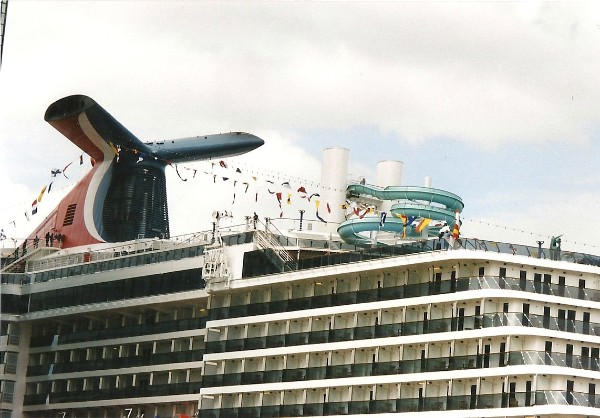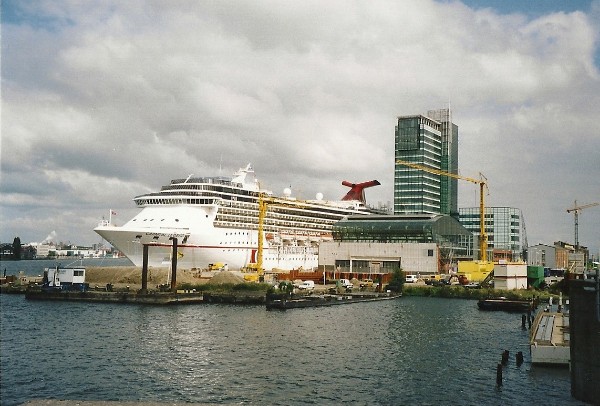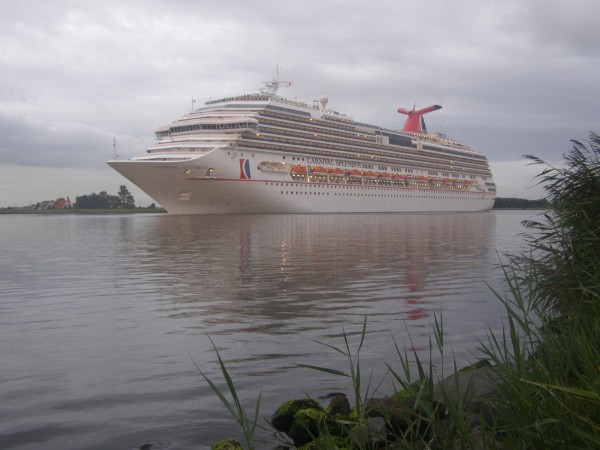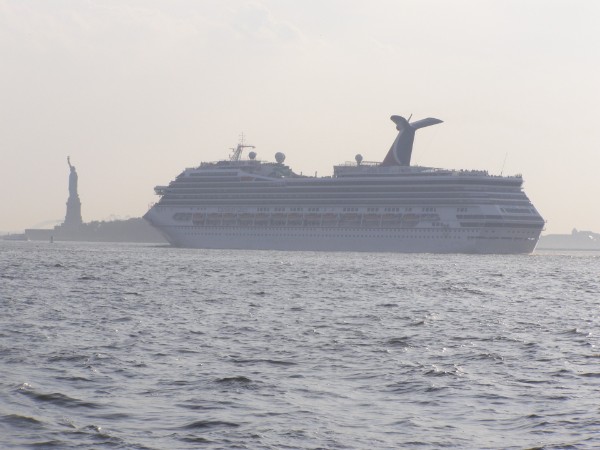Carnival Cruise Line
The most succesfull cruiseline in our time can only be one, Carnival Cruise Line. This company was formed in 1971 by the Israeli-born Ted Arison. He had been a partner of Knut Kloster, with whom he had founded the Norwegian Caribbean Lines out of his Norwegian company Klosters Rederi in 1966. After a disagreement with Kloster in 1971, Arison set up his own company. He used the name 'Carnival' from an old friend of his from Israel who was using this name for a part of his succesfull travelbusiness American International Travel Service in Boston, USA. His name was Meshulam Riklis. Arison had collected one and a half million dollars from passenger deposits paid for Nowegian Caribbean Line and together with Riklis, who had put up six and a half million dollars, he bought the Empress of Canada from Canadian Pacific. To keep up with the Carnival-name they renamed the ship Mardi Gras. Her positioning voyage from Tilbury to Miami started on the 26th of february 1972 and afterwards she started sailing Caribbean cruises.
Because of the bad financials at Carnival at that moment, the ship had to start sailing quickly, just six weeks after she was purchased to earn hard-value cash. Because of this, not much could be done to give the ship a new style, so during the cruises several parts of the ship had to be sectioned off for refurbishment and rebuilding. The only thing really done was to put a toilet and shower in every cabin, because this really was needed to start cruising. At her first cruise, departing Miami at the 11th of march 1972, the ship also went aground and rival companies named a cocktail after the failure of the newcomer 'Mardi Gras On The Rocks'. The ship was refloated one day later and all 530 passengers (mostly travelagents who were curious for the new line), had enjoyed themselves aboard as there was never any danger to the ship or passengers. Following refuelling at San Juan was paid partially from the cash-registers aboard at the cocktail lounges, as the company had to pay this in advance as they didn't have enough credits yet. Then, Canadian Pacific was not pleased because of the logo Carnival was using on its funnel. Riklis and Arison really liked the logo introduced by Canadian Pacific and because the logo wasn't used anymore by CP, they simply had restyled it only a bit by making the white 'c' smaller and giving it a slightly different shape. Also, the colours were changed from CP's green became Carnival's red and CP's black became blue. It wasn't that strange, the new company did not have the funds to design a new logo on such a short notice. The shape we now so closely link to Carnival was born out of a moneyless start. So Carnival did not begin so easily...
Because of the ship not being ready on time and several workmen were aboard always to finish the ships interiours, the passengers were not really enjoying their holidays. For Carnival, it made them change their minds that they were not in the shipping business but in the travel and leisure business. This way of re-thinking what excactly was the thing they were doing, affected their way of changing the cruise-industry in total, as it also affected the way they designed and marketed their ships afterwards. They wanted to introduce cruising to a younger and more modern kind of passenger so they were using a lot of neoncolours and music on their ships. In the first years, Carnival used the slogan 'The Flagship Of The Golden Fleet' to market the ship, but later admitted that there was no fleet and nothing was gold, that's for sure. This slogan was replaced with the 'Fun Ships' slogan and this worked from 1974 onwards. In this year, Riklis had to sell it's share in Carnival on behalf of the Nevada Gaming Commission (as AITS also owned a casino in Las Vegas), and Riklis did so for the sum of one dollar making Arison the sole owner of the operation. With the new slogan, Arison started targeting a younger croud seeking fun and holidays. It was a very succesfull change they brought into the cruising industry and from 1975 onwards they were making profit every year. This was mainly thanks to a new TV series at ABC called 'The Love Boat', starring the ships of rival Princess Cruises. Maybe we can say that Carnival would have died early if Princess did not help them. That was back then...
Below, the funnel and waterslides aboard Carnival Legend are shown. Note the people next to the funnel, showing how large it actually is. The winged, iconic funnel is a true Carnival trademark, based on the funnels of the transatlantic liner France of 1962. Even on top of the funnel, for the benefit of low-flying jets, the Carnival logo is present. In front of the Carnival offices in Miami, Florida, a full-size model of a funnel is placed to impress, well, everyone.

Two more ships were bought by the company, Carnivale (former Empress of Britain and Queen Anna Maria of 1955) in 1975 and Festivale (former Transvaal Castle and S.A. Vaal of 1961) in 1977. Festivale at the time was the sixth largest cruiseship in the world, boosting Carnival's capacity. In 1980 the company had their first newbuilding ordered, the 23.000-ton Tropicale. In that same year, Arisons former partner Kloster introduced a giant ship when he had the laid-up liner France rebuilt and she entered service as Norway for his Norwegian Caribbean Lines. With 66.300 tonnes this ship was bigger then anything else and I can imagine this was one of the reasons Arison started to order more and bigger ships for his own line. In 1985, the 46.000-ton Holiday was entering service for Carnival, followed by the slightly bigger Jubilee in 1986 and Celebration in 1987. In that same year 1987, Carnival was named 'Most Popular Cruise Line In The World', carrying more passengers then any other. But Arison was not done yet. The biggest order in the industry untill then was placed in the mid-1980's for Carnival, when eight 70.000 tonners were built to continue the constant growth of Arison's company. They entered in rapid succession between 1989 and 1998. This, of course, was the Fantasy-class.

Carnival Legend shown in Amsterdam during the first Carnival cruise in Northern Europe ever in 2002. At that time, the quayside was a large building project with the new cruiseterminal as the main building. Before the 1970's, these quays were used for the lineservices by the Netherlands Line, among others. These services mostly ran from Amsterdam to the Dutch Indies. In the middle of the picture you can also spot the burned out remains of the 1896-build Mississippi-paddlesteamer Mark Twain. In januari of 1999, a fallen candle had spelled the end for the century old ship, that was the only former Mississippisteamboat in Europe. At the time the ship burned, she was used by squatters as a home for drugaddicts and formally owned by Mammoet Shipping, a daughtercompany of Holland America Line.
Carnival did not only built new ships. They also started to take over some older lines that were not entirely sure of their financial future. In january 1989, the well-known Holland America Line was taken over, together with Westours (Alaska) and Windstar Cruises. This was somewhat a surprise move, because earlier Carnival had tried to take over the business of the Royal Caribbean Cruise Line, but this did not work out well. Carnival kept the old name of the company alive and did not merge HAL into their own brand. This was a good move, because within Holland America Line, Carnival could attract another kind of passenger that would never travel with the popular Carnival-ships. In 1992, the luxury cruiseline Seabourn was added to the company, also without change of name. Two years later, Carnival set up a new mothercompany for all these brands named Carnival Corporation, also known as The Worlds Leading Cruise Lines Alliance.
In 1997 the Italian Costa Crociere was taken over and made part of the Carnival Corporation. A year later, Cunard Line was bought and nobody could disagree that Carnival was now truly the biggest company in the industry. The comparissement with J.P. Morgans International Merchantile Marine Corporation (IMMC) that tried to dominate the Atlantic lines in the first decades of the 20th century is easily made. Also IMMC started to shift ships and classes between all brands and both (IMMC and Carnival) tried to keep the companies as seperate brands. Of course, IMMC failed in the 1920's and was restarted as United States Lines after the first worldwar.
There was only one company that could keep up with Carnival, the 1969-formed Royal Caribbean Cruise Line. This company also grew rapidly itself and they also started to buy other lines like Celebrity Cruises (the old Chandris Lines) in 1997 and the Spanish-based Pullmantur Cruises in 2006. Also, Royal Caribbean Cruise Line was eager to built the biggest cruiseships in the world. So when it was announced that RCCL would merge with P&O Princess cruises in 2002, Carnival immidiately acted. Otherwise, the new combination would be bigger then Carnival Corporation. After a very complex period, Carnival Corporation won the battle and P&O Princess was added to the company. Because of this, there now was no real competition left for Carnival anymore. P&O Princess was of course an immense player in the market, adding as most important parts the fleets of P&O Cruises, Princess Cruises and AIDA Cruises to Carnivals imperium. NCL/ Star Cruises was in financially bad weather, Royal Caribbean International was big, but not a threat anymore and the ever growing MSC Cruises was still way to small for the immense company Carnival had become. Carnival also stopped competing for the biggest ship in the world and let Royal Caribbean win that battle with ease.
For all these brands new ships were on order. For Carnival Cruise Lines came also a time of expansion with many more big cruiseships. The old ships from the beginning were sold or scrapped and a new class was evolving. In 1996, Carnival Destiny came into service. It was the biggest ship in the world and not only that, she was also the first to register just above 100.000 tonnes. Five ships of the Destiny-class were ordered from which two went to Costa Cruises and three to Carnival itself. Nearly the same period, another class was built for Carnival and Costa named the Spirit-class, after the first Carnival ship that entered service within this class, the Carnival Spirit. Four ships of this class were added to the fleet of Carnival and two were built for Costa (see the Costa Cruises section). A unit of this class is shown at the second picture on this page, the Carnival Legend, that entered service in 2002. The ship is shown at the terminal in Amsterdam on the first European cruise ever under the Carnival-name.

The newest ships of the line show that also Carnival had grown up and they are a lot less glittery and neon-filled than their earlier fleetmates. The decor now is a lot more quiet, although still astonishing because of their 'house-designer' Joseph Farcas way of designing ships. Somehow, also the Carnival passengers from the beginning are getting a little older and desire a different and more adult atmosphere.
The growth of the industry was enormous around the start of the new millennium and because of the huge financial reserves of the monstrous company new ships were ordered even before the last ones were sent to sea and proven succesfull. A new, enlarged version of the Destiny-class came in service for Carnival, exsisting of five ships. After these, a ship based on the same design but with an extra deck added entered service in 2008, the Carnival Splendor, pictured just above during her first season sailing Northern European cruises. At the time she entered service, she was the biggest ship Carnival ever built. But, although they were not competing for the biggest ship in the world-contest and put aside the pinnacle-project (a ship of around 180.000 tonnes), three very large ships were added to the fleet in these years, the Carnival Dream in 2009, Carnival Magic in 2011 and Carnival Breeze in 2014, all 130.000 tonners.
Carnival also is a company that keeps investing in the surroundings where the ships are sailing in. Companywide, Carnival invests heavily in environmentfriendly fuelsources like LNG, bringin on the first partially LNG-fuelled ship AIDAprima for the AIDA Cruises fleet in 2016 and the fully LNG-powered AIDAnova in 2018. Also fleetwide installations of so-called scrubbersystems in the exhausts of the ships reduce emissions significantly up to over 90% per ship.
Humanitarian and social aid is also given, through Fathom Impact Travel in 2016, next to the 12 million dollar in relief-aid for the hardest hit countries during the hurricanes Harvey, Irma and Maria in the Caribbean. This next to the cruiseships of the company that were chartered to provide shelter and housing as well as the transport of humanitarian aid to the islands. It really shows that the industry leaders are not only polluting and destroying the world by growing mass-tourism but also are up in front by new enivonmentalfriendly possibilities and social responsibility.

A ship that has been sailing for Carnival but is placed elsewhere is
Holiday (1985-2009) is placed as Magellan under CMV Cruises.
For booking information, visit the website of Carnival Cruise Lines.

